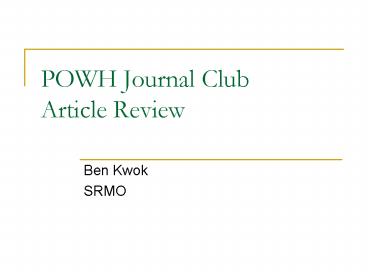POWH Journal Club Article Review PowerPoint PPT Presentation
1 / 12
Title: POWH Journal Club Article Review
1
POWH Journal ClubArticle Review
- Ben Kwok
- SRMO
2
The Clinical Value of Systemic Inflammatory
Response Syndrome (SIRS) in Abdominal Aortic
Aneurysm Repair
- Norwood M, Bown M, Lloyd G, Bell P, Sayers R.
- Dept of Surg, University of Leicester, Leicester,
UK - Eur J Vasc Endovasc Surg 2004 27(3) 292-298
3
Purpose
- To determine whether number of SIRS criteria and
timing of SIRS correlates with multiple organ
failure (MOF) and outcome in patients after AAA
surgery
4
Background
- SIRS 2 or more of these criteria (Bone et al
Chest 1992) - WCCgt12 or lt4 or gt10 immature (band) forms
- Temp gt38C or lt36C
- Heart Rate gt 90/min
- Resp Rate gt20/min or PaCO2 lt 4.3kPa (32.25 mmHg)
- SIRS ? sepsis ? septic shock ? multiple organ
dysfunction
5
Methods
- 151 consecutive AAA repair patients prospectively
recruited (Oct 00-Apr 02) - Inclusion criteria- Any AAA repair
- Elective (100)
- Urgent (16) symptomatic repair lt24h post
admission - Ruptured (35) intra or retroperitoneal blood at
laparotomy - No exclusion criteria
- Daily record post-op of SIRS score
- number of SIRS criteria 0-4
6
Methods
- Outcome measures included
- Organ failure as defined by Knaus et al (Ann Surg
1985) multiple if gt2 organs failed - Mortality
- Length of stay in hospital
- Length of stay in surgical ward
- Length of stay in critical care unit
7
Organ Failure
8
Results Elective AAA
- 89 - SIRS at some point during admission
- 54 - SIRS only during first 3 post-op days
- Pts that died (n5) had prolonged and higher mean
SIRS scores 2.19 c/w 0.95 (plt0.01) - High early SIRS score ? no correlation with
adverse outcome - Cumulative SIRS score gt10 in 1st 4 post-op days
correlated with higher mortality (p0.02 Fishers
exact test)
9
Results Elective AAA
- SIRS scores of 3 or 4 during 1st 4 post-op days
had higher incidence of MOF. - 1/51 with SIRS score2 developed MOF
- 6/49 with SIRS score3 developed MOF
- BUT No statistically significant difference
(Fishers exact test p0.06) - If SIRS during 5th-10th day post-op
- more likely to die (p0.01 Fishers exact test)
- longer ward stay (16.37 days vs 10.94 days)
p0.02 Students t-test)
10
Results Ruptured AAA
- All 35 patients had SIRS post-op
- Non-survivors had higher mean SIRS score than
survivors 2.06 vs 1.37 (plt0.01 t-test) BUT no
difference in survival whether peak SIRS score
was 2, 3 or 4 (no test or p-value quoted) - Pts that stayed in hospital longer than the mean
time had higher mean SIRS score 1.76 vs 1.26
(p0.04) - Again, No statistically significant correlation
between tighter SIRS criteria (3 or 4) and MOF
(p0.85 ?2)
11
Conclusions of Authors
- No correlation between precise number of SIRS
criteria and mortality, length of hospital stay
or organ failure - In elective AAA repairs
- High cumulative SIRS scores (10) in 1st 4 days
post-op?more likely to die - High SIRS score on isolated days not associated
with increased mortality - Presence of SIRS from day 5-10?longer hospital
stay and higher mortality (not influenced by peak
SIRS score) - In ruptured AAA repairs
- Early high SIRS scores regardless of outcome
12
Problems
- No statistically significant correlation between
MOF and tighter SIRS definition (3 or 4 criteria) - ? Any correlation between SIRS and MOF at all in
this study not looked at in this study - ? SIRS ? sepsis ? septic shock ? multiple organ
dysfunction hypothesis still valid - More complex analysis of data required to find
significant results

